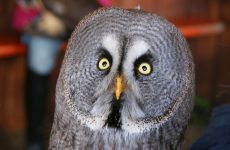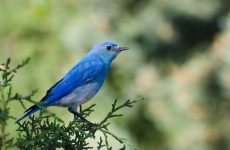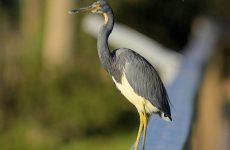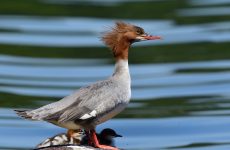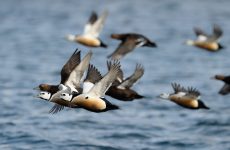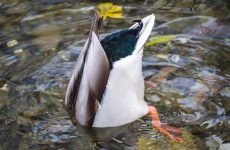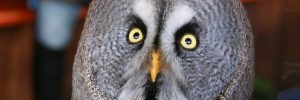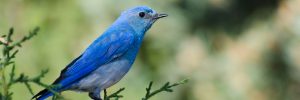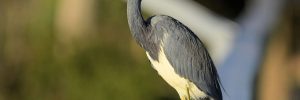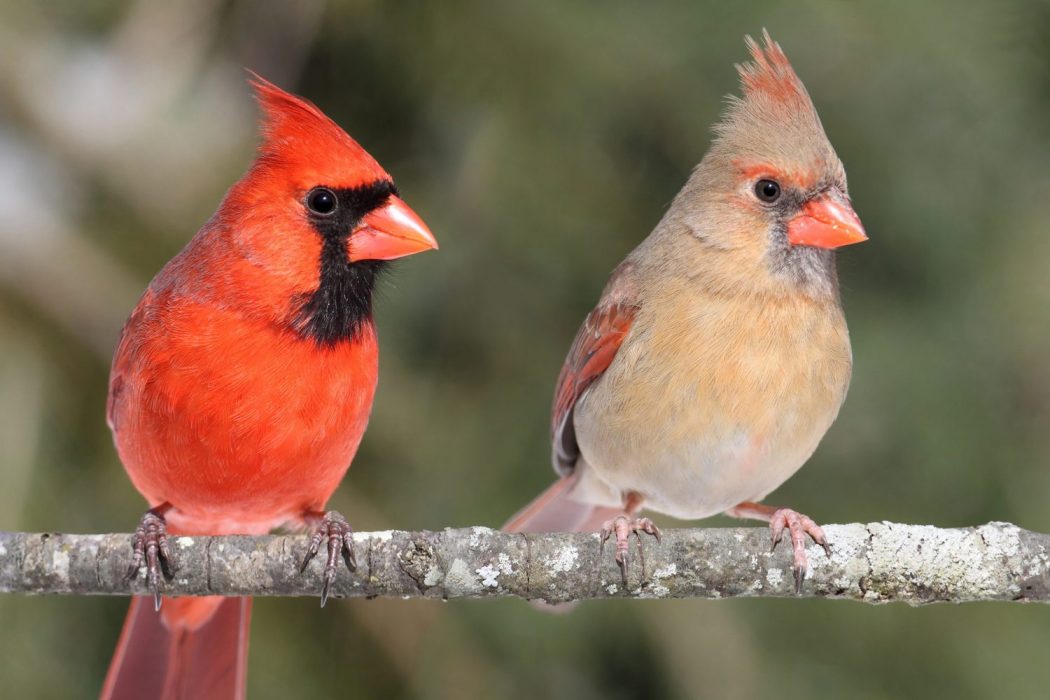
Have you spotted a bird with a red head that you want to identify? Surely it can’t be that hard, but there are so many birds that have red on their heads so how are you supposed to know where to start?
25 Birds with Red Heads:
- Northern Cardinal (35%)
- House Finch (23.8%)
- Downy Woodpecker (23.6%)
- Red-bellied Woodpecker (21.2%)
- Barn Swallow (11.1%)
- Hairy Woodpecker (8%)
- Pileated Woodpecker (6.3%)
- Anna’s Hummingbird (5.8%)
- Ruby-throated Hummingbird (5.4%)
- Palm Warbler (3.5%)
- Yellow-bellied Sapsucker (3%)
- Purple Finch (2.9%)
- Scarlet Tanager (2.3%)
- Acorn Woodpecker (2%)
- Red-headed Woodpecker (2%)
- Redhead (1.9%)
- Summer Tanager (1.7%)
- Western Tanager (1.5%)
- Vermilion Flycatcher (0.7%)
- Red Crossbill (0.6%)
- Cassin’s Finch (0.5%)
- Red-breasted Sapsucker (0.5%)
- Common Redpoll (0.5%)
- Pyrrhuloxia (0.4%)
- Pine Grosbeak (0.2%)
Well, these are the most common birds that have red heads or have red on their heads or throats.
500 birds with red anywhere on their heads were cross-referenced with all 1000 species of birds sighted in North America to give you the top 25 birds with a red head. The percentages show how often these birds were recorded in checklists on ebird.org.
This article gives you identification information and photos to help you identify these birds with red heads.
25 birds with red heads
1. Northern Cardinal
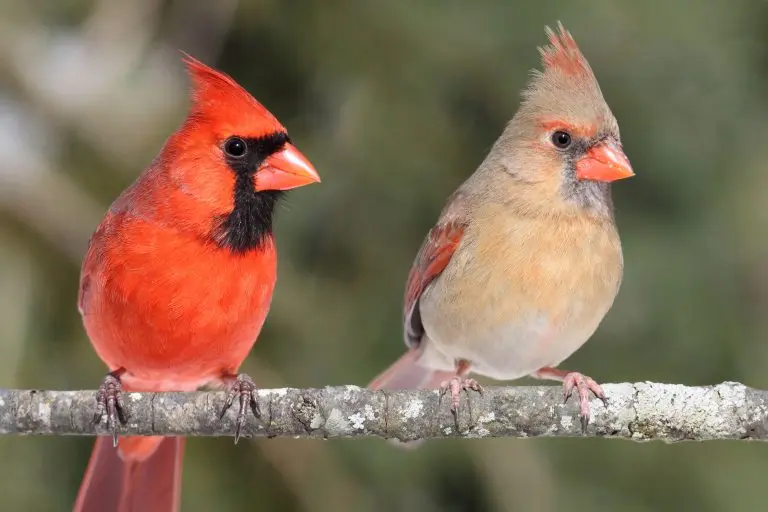
The bright red male Northern Cardinal is a bird with a red head, body and tail, with black around their faces. They are a great sight, especially against a white winter background. The females are also a little showy with their brown coloring, sharp brown crest, red highlights, and red beaks.
Northern Cardinals are found in eastern and southern states and will sometimes attack their own reflection during breeding season as they obsessively defend their territories.
You can attract more Northern Cardinals to backyard feeders with sunflower seeds, peanut hearts, millet, and milo.
They will feed on large tube feeders, hoppers, platform feeders, or food scattered on the ground.
2. House Finch
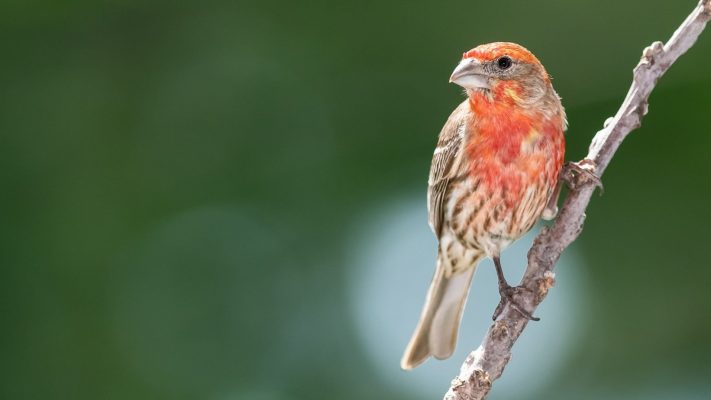
House Finches are another bird with a red head and breast in the males and brown-streaked coloring in the females. Originally only in western states it was introduced to the eastern states and has done very well, even pushing out the Purple Finch.
They can be found in parks, farms, forest edges, and backyard feeders. They can be found in noisy groups that are hard to miss.
You can attract more House Finches to backyard feeders with black oil sunflower seeds or nyjer seeds in tube feeders or platform feeders.
3. Downy Woodpecker
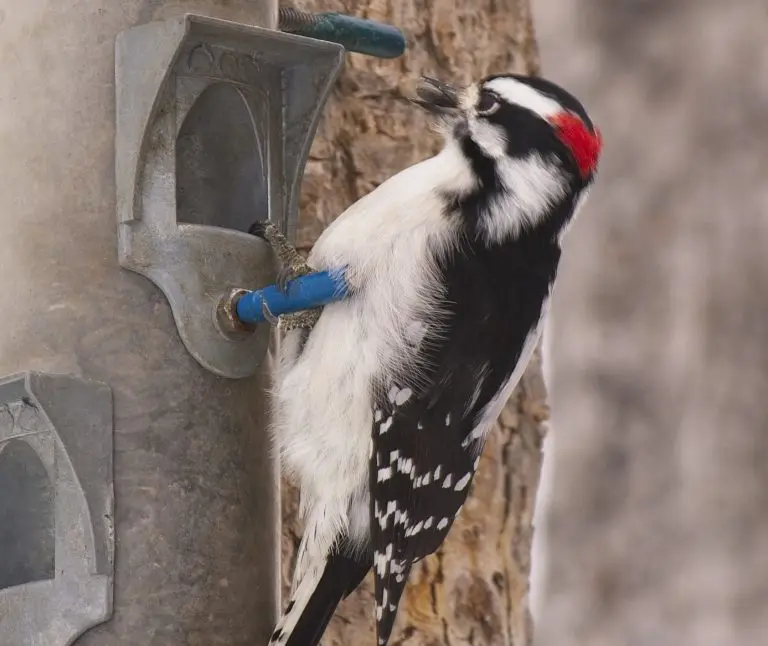
Downy Woodpeckers are small birds that are common at backyard feeders. They are common across most states.
This bird has a red head patch at the back of their heads in the males. Male and females woodpeckers look different. Males often have a red patch.
They are often mixed in with other birds such as chickadees and nuthatches. They have black and white coloring. They look similar to the Hairy Woodpecker.
To attract more Downy Woodpeckers to your backyard try suet feeders but they will also eat black oil sunflower seeds, millet, and peanuts on platform feeders.
4. Red-bellied Woodpecker
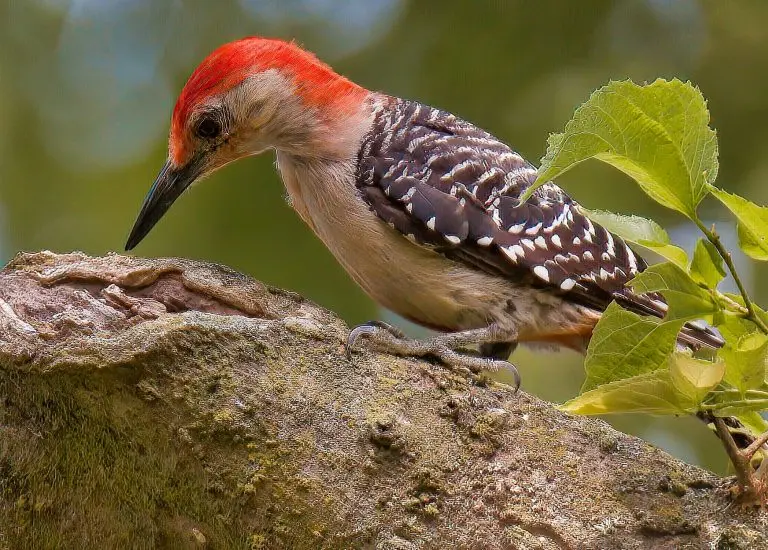
Red-bellied Woodpeckers have a pale red belly that can be difficult to spot. This bird with a red head and nape also has a black-and-white striped back.
They are found in Eastern states. They make a loud call in spring and summer and are found in woods and forests, especially with deadwood. They are a woodpecker that migrates.
You can attract more Red-bellied Woodpeckers with suet feeders and they will sometimes feed on hummingbird feeders.
5. Barn Swallow
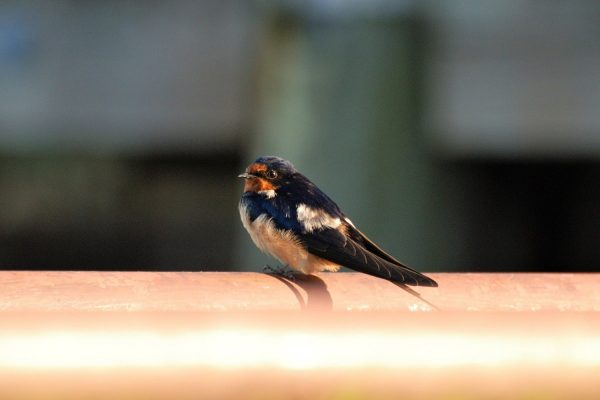
Barn Swallows have rusty red faces and tawny underparts and blue backs, wings, and tails. They breed across most of North America before migrating south for the winter.
They are usually found darting over fields and open water in search of food and make mud nests in human-made structures, such as barns.
You can attract more Barn Swallows to your backyard with ground-up eggshells on a platform feeder or by providing a suitable place to nest by leaving an outbuilding or barn door open.
6. Hairy Woodpecker
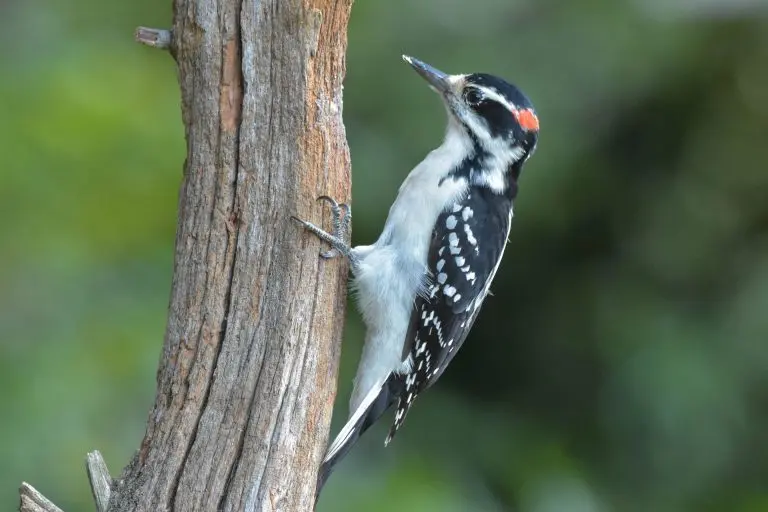
The Hairy Woodpecker can be found across most of North America. These black and white birds have a red spot on their heads.
They are slightly larger than their look alike the Downy Woodpecker. They can be found in large trees and can be heard tapping if you listen for them.
Woodpeckers are fascinating and there are many interesting woodpecker facts to learn.
You can attract more Hairy Woodpeckers with suet feeders, especially in winter.
7. Pileated Woodpecker
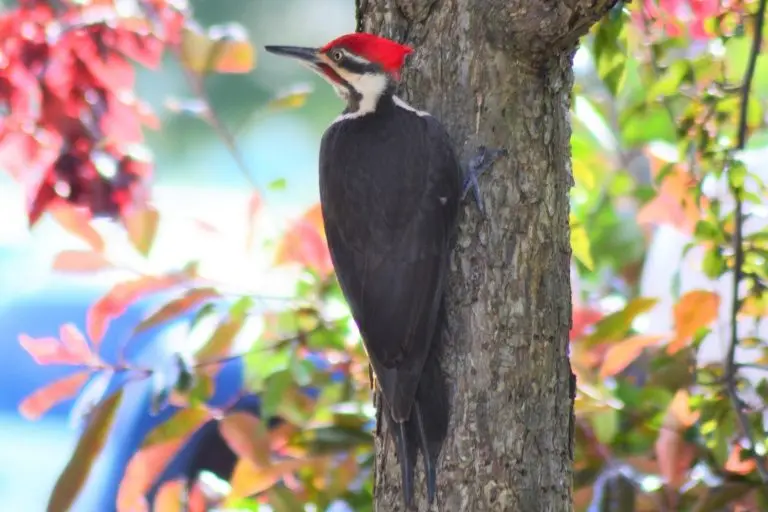
The Pileated Woodpecker has a red head in the form of a bright red crest against a predominantly black body with white stripes. It can be found in Eastern states and along the coast in the north-west.
It is a large bird being nearly the size of a crow and prefers dead wood to forage for carpenter ants. You can attract more Pileated Woodpeckers with suet feeders.
8. Anna’s Hummingbird
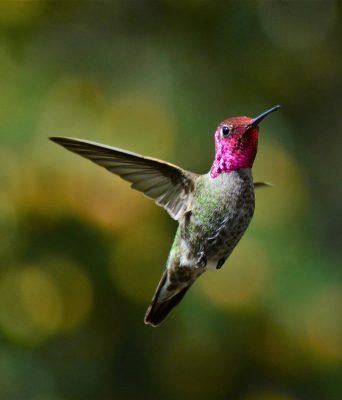
Anna’s Hummingbirds have rose-pink throats and emerald green across most of their bodies in the male. Females hummingbirds are less colorful.
They are about the size of a ping-pong ball and will often be found at hummingbird feeders or plant large colorful blossoms to attract hummingbirds in spring.
They are common along the Pacific Coast and they make a fantastic diving display during the breeding season with the males diving near vertically.
9. Ruby-throated Hummingbird
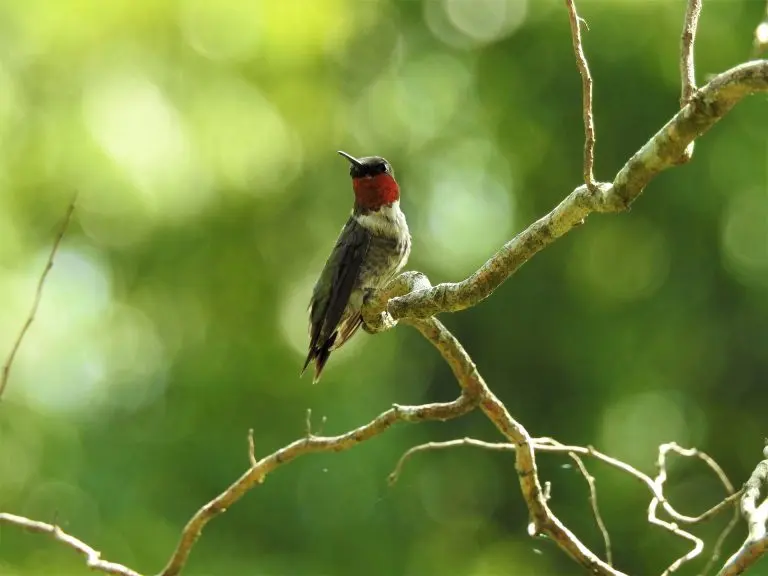
The Ruby-throated Hummingbird is predominantly green with a red flash of ruby at the throat in the male. Male and females hummingbirds are different with females being less brightly colored.
They breed in eastern states before migrating south.
They can be found in flower gardens or woodland edges and often visit hummingbird feeders. Hummingbirds feed on tubular flowers such as trumpet creepers or cardinal flowers, honeysuckle, jewelweed, bee-balm, red buckeye and red morning glory. They also fed on insects.
10. Palm Warbler
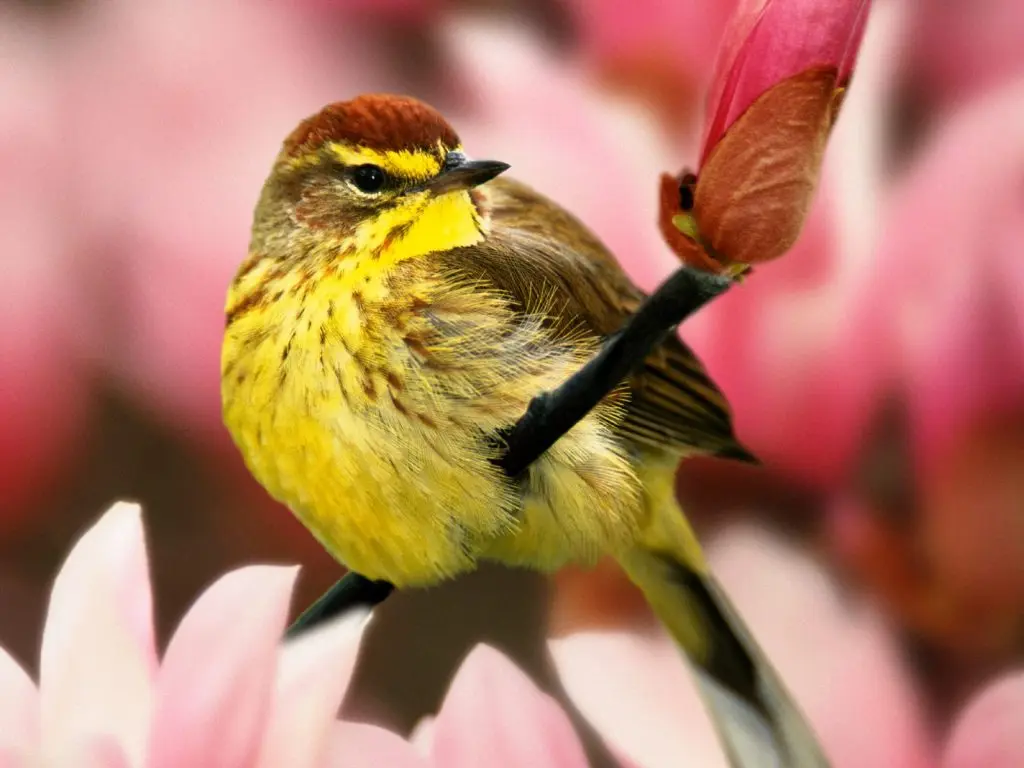
The palm warbler has a rusty red patch on the top of their heads and is a browny-olive color on the back and yellow underneath over the rest of its body. The breed in Canada but can be found in eastern states during the migration and all year along the far south coast and Florida.
Spring and fall is the best time to spot warblers in weedy fields, forest edges, and scrubby areas. They are often found foraging along the ground for insects, mixed in with other birds such as Sparrows, Juncos, and Yellow-rumped Warblers.
11. Yellow-bellied Sapsucker
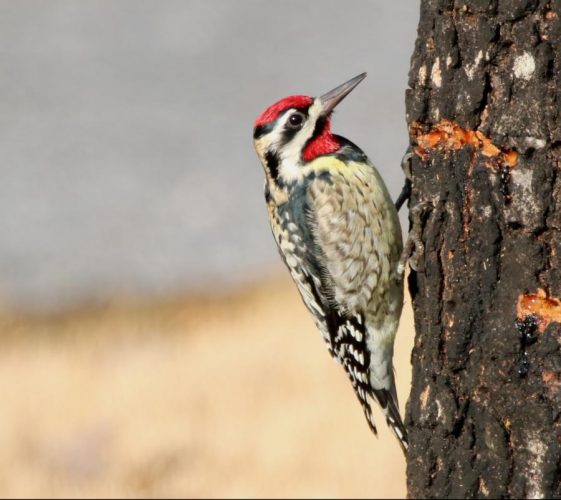
Yellow-bellied Sapsuckers are black and white birds with a red patch on the top of their heads and throat and with a pale yellow belly.
They breed in the far north and Canada and winter in the southeast. They can be spotted in forests and leave tail-tale rows of shallow holes in tree bark where they have been eating sap using their brush-tipped tongue. They may visit suet feeders.
12. Purple Finch
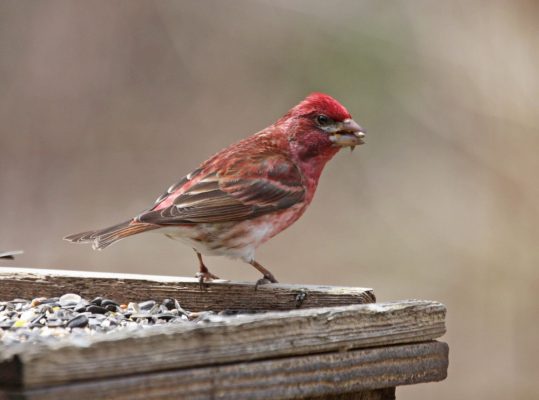
Purple Finch look very similar to House Finch with the reddish-purple head and breast with more brown on the back and wings.
They breed in Canada and overwinter in eastern states but can be found all year in the north-east are Pacific coast. They readily come to feeders for black oil sunflower seeds.
13. Scarlet Tanager
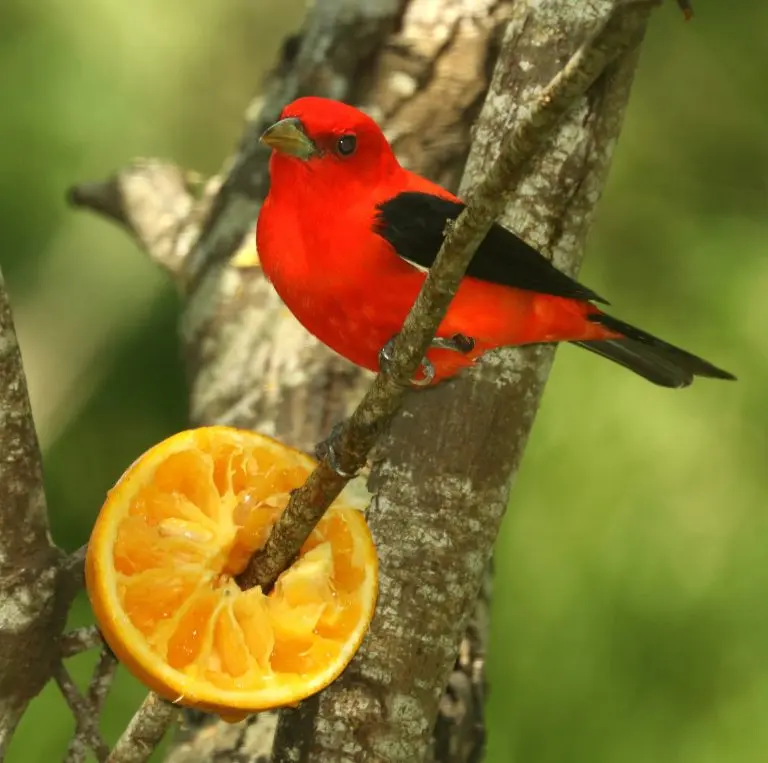
Scarlet Tanagers are birds with red heads and bodies, that is very bright, and with black wings and tail. They breed in eastern forests in summer before migrating to South America.
Scarlet Tanagers can be hard to spot as they stay high in the forest canopy.
You can attract more Scarlet Tanagers by planting berry plants such as blackberries, raspberries, huckleberries, juneberries, serviceberries, mulberries, strawberries and chokeberries.
14. Acorn Woodpecker
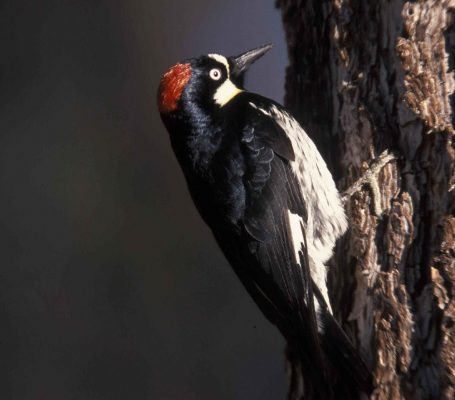
Acorn Woodpeckers have bright red crests, white faces, black backs, and whiteish-black underparts. Their range is small in North America just some areas in southern states and a little along the California coast.
They live in large groups in western oak woodlands and store thousands of acorns by jamming them into the specially made holes in trees. There are quite a few interesting and gross facts about Acorn woodpeckers.
They make loud parrot-like squarks from the top of trees. They may visit seed and suet feeders.
Check out these quick photo ID guides:
15. Red-headed Woodpecker
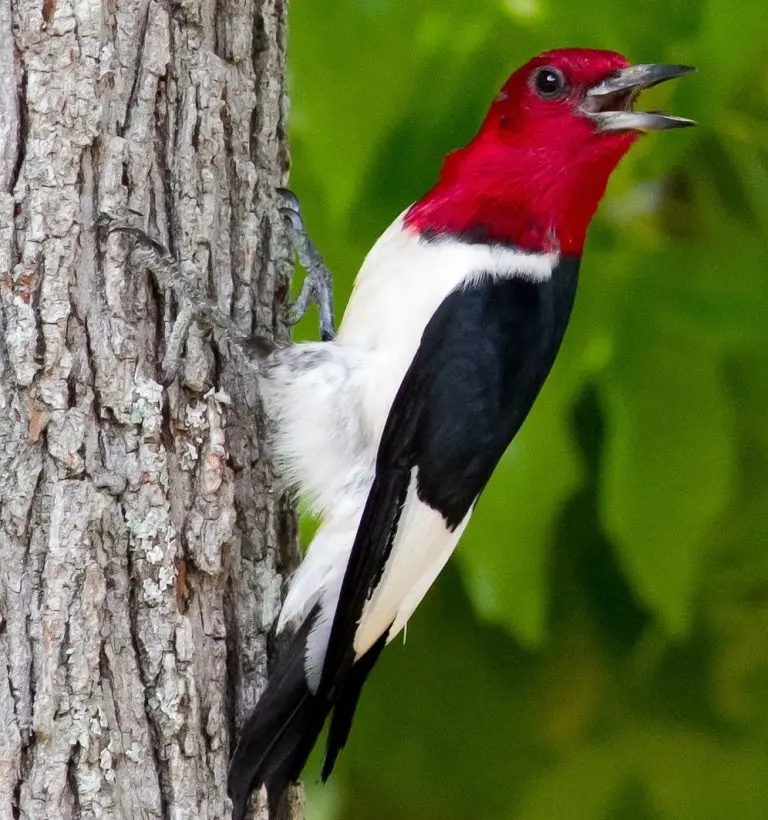
Red-headed Woodpeckers are birds with red heads as their name would suggest. They have white bodies and white and black wings. They can be found all year in eastern states and breed but migrate from the far north-west of their range for winter.
They can be found in open woodlots and dead timber in swamps or pine savannas. They store food such as insects and seeds in cracks in wood or under bark or roof shingles.
They are fierce defenders of their territory and will even remove or puncture the eggs of other species’ nests. Red-headed Woodpeckers can be attracted with suet feeders and fruit.
16. Redhead
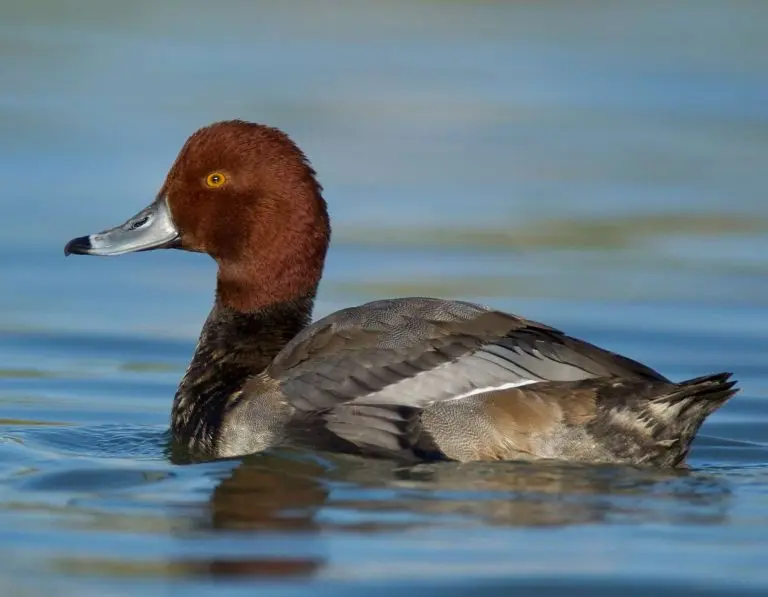
The Redhead duck has a reddish-brown head, black breast and tail, and grey body.
They can be found across all states especially in winter where they can be found in flocks numbering the thousands, especially along the Gulf Coast.
In summer they can be found nesting in reedy ponds of the Great Plains and West.
17. Summer Tanager
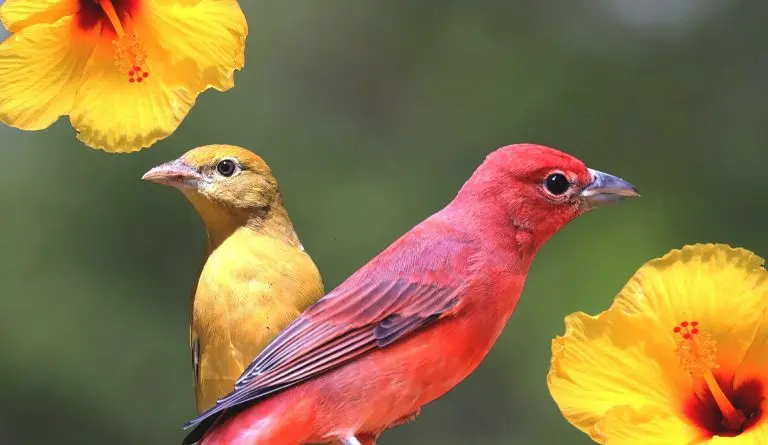
Summer Tanager males are bright red all over, with the females being yellow. They breed in southern and eastern states before heading to Central and South America for winter.
They are forest songbirds and can be found in open woodlands and feed on bees and wasps in mid-flight. They catch them and kill them by beating them against a branch and rubs the stinger off before eating them.
You can attract more Summer Tanagers to your backyard with berry bushes and fruit trees.
18.Western Tanager
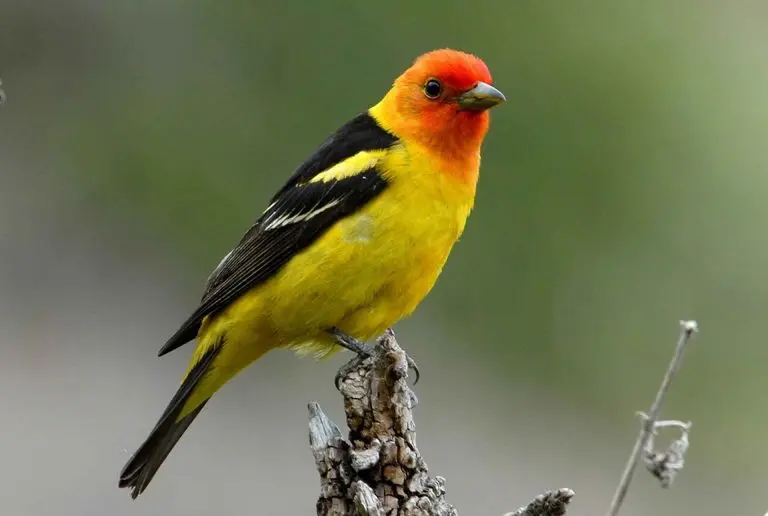
Western Tanagers have a flaming orange-red head, yellow body, and black wings. they can be found all over western states breeding towards the north and then migrating south for winter.
They live in open conifer forests but stay hidden in the canopy, despite their bright coloring. The red coloring probably comes from eating insects that produce a pigment that the Western Tanagers cannot produce themselves.
You can attract Western Tanagers with dried fruit, cut oranges, and other fruits from bird feeders.
19. Vermilion Flycatcher
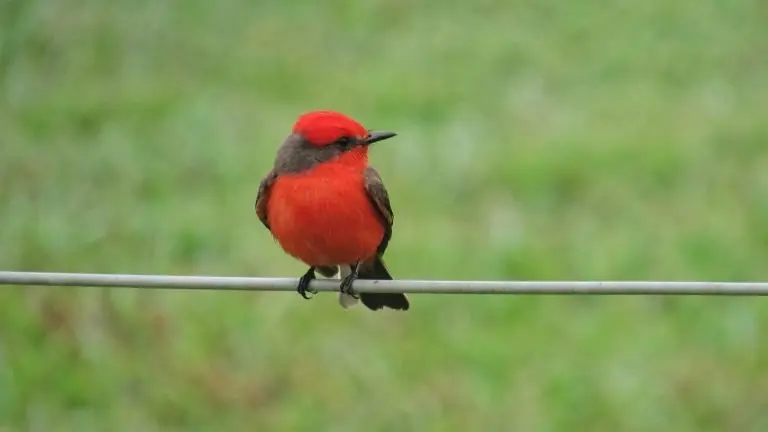
The Vermilion Flycatcher has a bright red crest and throat and breast and black along the back and wings with a black eye stripe.
They can be found all year in the far south in desert landscapes catching insects or sitting on exposed perches.
They are fairly common in the southwest but also along the Gulf Coast in smaller numbers.
20. Red Crossbill
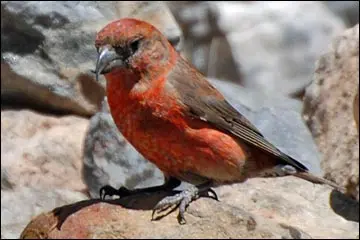
Red Crossbill males are brick red overall with darker wings and tails. They can be found year-round in northern and western states and in winter in eastern states.
They feed on conifer seeds and forage in flocks from tree to tree, even breaking unopened cones with their powerful beaks. As well as coniferous forests they can be found along roadsides consuming grit in the mornings.
21. Cassin’s Finch
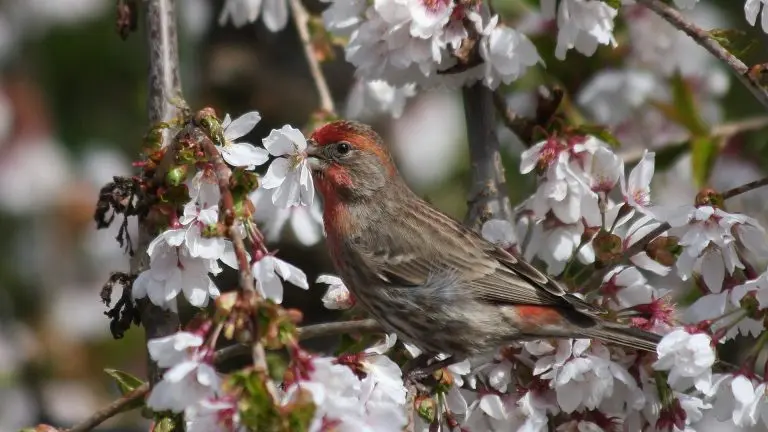
Cassin’s Finches have a red crown and rosy pink head and breast with whiteish belly and brown back and wings. they can be found in mountain forests in western states foraging in flocks for seeds.
They are not as common in backyards as House or Purple Finches but they may be attracted with sunflower seed feeders especially in winter or fruiting shrubs such as cotoneaster, mulberries, firethorn, grape and apple.
22. Red-breasted Sapsucker
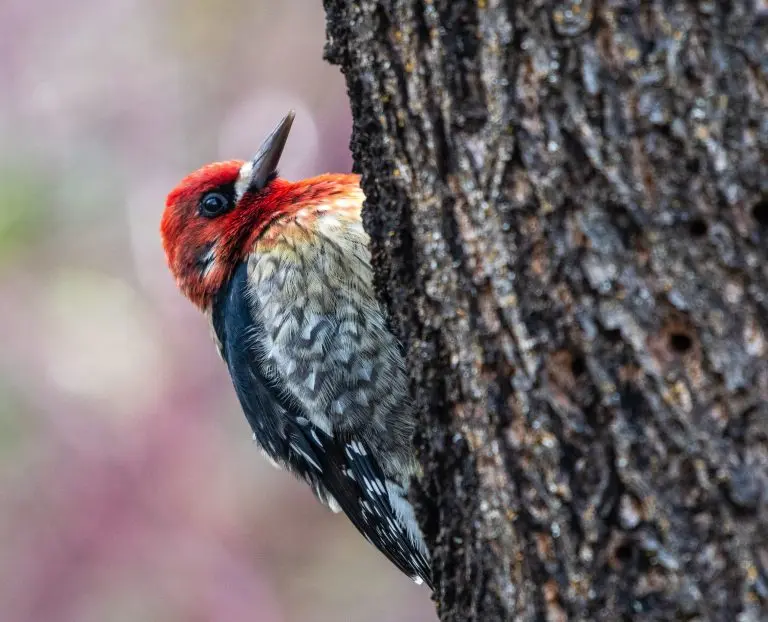
Red-breasted Sapsuckers are birds with red heads and breasts with black and white backs and wings and off-white bellies. They can be found along the Pacific Coast all year primarily in coniferous forests.
They make holes in trees to drink the sap and then hummingbirds will make use of them to also feed. They also eat fruit and insects.
23. Common Redpoll
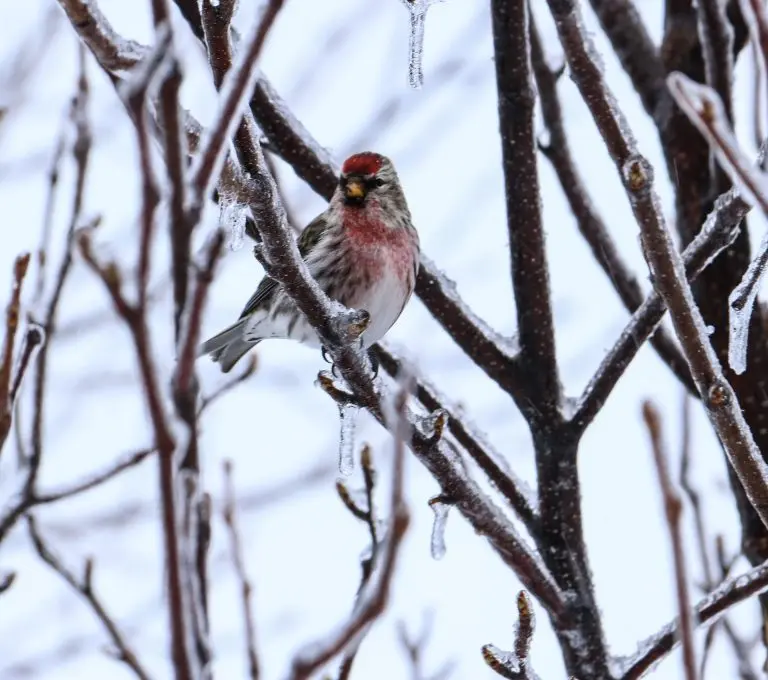
Common Redpolls have red foreheads, pinky breasts, and are brown and white over the rest of their bodies. They can be found in winter in northern states and less frequently in central states.
In winter they will sometimes tunnel into the snow to stay warm during the night. They can eat up to 42% of their body mass every day and can store up to 2 grams of seeds in a stretchy park of their esophagus.
They can be found in weedy fields or feeding on catkins in trees but they will also come to feeders for small seeds such as nyjer seeds or thistle.
24. Pyrrhuloxia
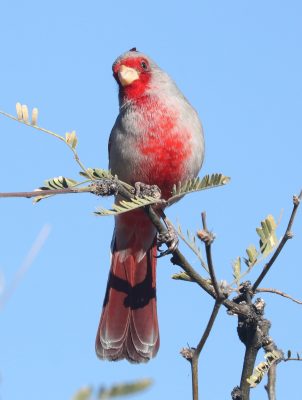
Pyrrhuloxia males are grey with red accents to the face, crest and have red running down the breast and tail. They are residents of the hot deserts of the southwest.
During the breeding season, they fiercely defend their territory but in winter they can be found in flocks of up to 1000.
Pyrrhuloxia feed on seeds but also insects and can be found at feeders with sunflower seeds but more often prefer them scattered on the ground.
25. Pine Grosbeak
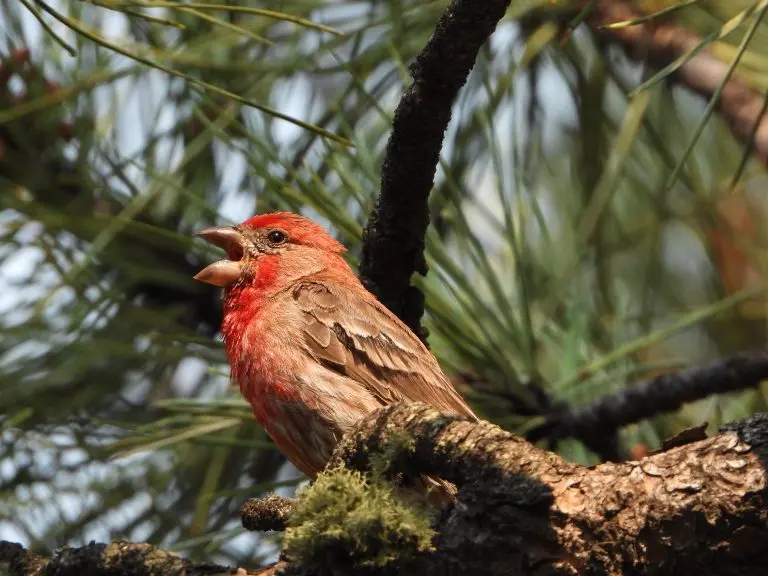
Pine Grosbeaks are a species of finch with the males having red heads, breasts, and backs and grey over the rest of their bodies and wings. They are large for finches and relatively slow.
They can be found in parts of the West during summer in open spruce and pine forests, or in winter in northern states. You can attract Pine Grosbeaks to black oil sunflower seed feeders in winter in the northern states.
Conclusion
As you can see there are many birds with red heads, but this list should help you start to identify any birds with a red head that you spot.

